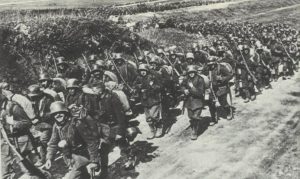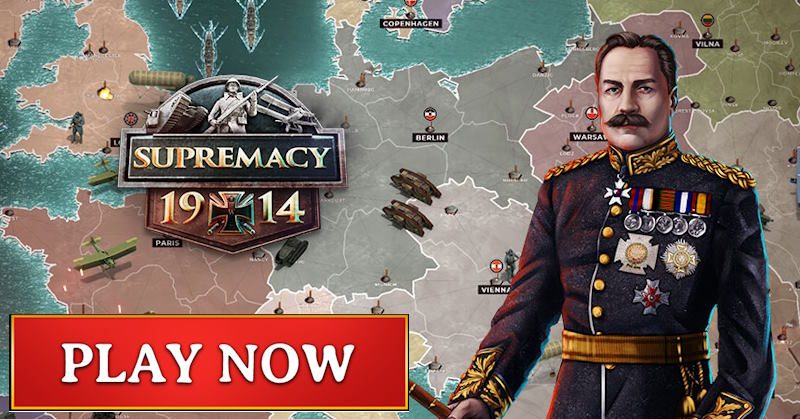The monthly days of 1918:
- January 1918
- February 1918
- March 1918
- April 1918
- May 1918
- June 1918
- July 1918
- August 1918
- September 1918
- October 1918
- November 1918
- December 1918
The situation at the fronts in 1918.
He calculated that the American Army would be unable to intervene decisively in France before the early summer of 1918: It seemed to Ludendorff, therefore, that Germany could take no other course but to transfer divisions from Russia to the West and, by exploiting her temporary superiority in the field, achieve a decisive victory over Britain and France before the Americans began to arrive en masse – Germany’s last hope of winning the greatest conflict in history so far.
After prolonged discussion and disagreement, Ludendorff rather belatedly reached a decision to direct the main weight of his grand offensive on the British-held St Quentin (Somme) sector (code name ‘Operation Michael’). The aim was to drive west between Peronne and Arras towards the Channel coast. ‘If this blow succeeded, the strategic result might indeed be enormous, as we should separate the bulk of the English army from the French and crowd it up with its back to the sea…’ (My War Memories 1914-1918 by Erich Ludendorff).
The ambitious plan depended for success on the maximum exploitation of the novel’ storm troop’ tactics evolved in Russia (notably by General Hutier and artillery Colonel Bruchmueller) and first employed at Riga. These specially trained formations – armed with light machine-guns, rifles, flamethrowers, mortars and a sprinkling of field guns – had orders to infiltrate as fast as their legs could carry them, bypassing Allied strong points. In a reversal of accepted tactical doctrine, reserves would be put in where the attack was progressing, not where it was held up.
Special artillery tactics involved a crushing short bombardment of a few hours’ duration using a 4:1 preponderance of gas projectiles, to dislocate and paralyze the defenders. But, despite the vital need to maintain the momentum of advance, no attempt was made to create a German tank corps on the British or French model, and both cavalry and supply units were seriously embarrassed by a lack of horses.
Nevertheless, the German Kaiserschlacht (‘Emperor’s Battle’) offensive began in spectacular fashion on 21 March 1918. Between 23 and 25 March Ludendorff was within reach of victory as the outnumbered British Third and Fifth Army began ‘the Great Retreat’. However, Ludendorff’s Teutonic inflexibility and his basic flaws of character and intellect now revealed themselves: the nearness of the Allied front and Allied solidarity to final collapse was not apparent from the reports of his own armies. Above all, the pattern of success on the ground had failed to correspond with the strategic character of the Michael plan, of the three attacking generals only Hutier [Eighteenth Army] had achieved the kind of swift, deep advance which Ludendorff had been counting on. Yet under the original Michael strategy, Hutier’s role was the subsidiary one of the flank guard. The German success was all on the wrong wing.
If on 23 March 1918, Ludendorff had chosen to throw all his ‘attack’ divisions behind a single thrust by Hutier and the left-wing of Marwitz’s Second Army towards Amiens (‘hinge’ of the Anglo-French front), there is every possibility that an ineradicable wedge could have been driven between the British and French with devastating psychological effects on the defeatist Petain (no longer the indomitable ‘Victor of Verdun’).
Instead, Ludendorff waffled and ordered no fewer than three separate thrusts by his three armies. It was all a fatal dispersion of effort, a plan beyond the powers of his rapidly tiring troops. Although Hutier crossed the Somme on a broad front, even he fell 6-10 miles (ca. 16 km) short of his objectives. On 25 March Ludendorff drastically revised his directive of the 23rd, but only succeeded in dissipating his chances of a decisive breakthrough. Only on 28 March (four days too late), did he order an all-out attack on Amiens. By then, the crisis in the Allied command set-up had been overcome, Foch being appointed Supreme Commander.
Throughout April, late May, early June and half of July, Ludendorff continued to ring the changes with another four massive blows, and bellow down the field telephone at his increasingly resentful and frustrated generals. Even so, by June the Allies had lost all they had gained since 1915 and the Germans had reached the River Marne for the second time in the war. But they had nowhere succeeded in permanently breaking the Allied line, while American troops were now in action in ever-increasing numbers. Fifteen US divisions landed in France between April and June 1918.
On 15 July the Germans attacked simultaneously on both sides of Reims (Aisne Salient). East of that constantly bombarded city, they made slight gains. To the west, they crossed the Marne. Foch replied with a massive artillery bombardment followed by a decisive counter-attack (18 July-6 August) spearheaded by swarms of fighters, light bombers and ‘fast’ light Renault FT-17 tanks. Nine American divisions supported powerful French units. In this Second Battle of the Marne, the Germans were forced back to the River Vesle.
On 15 September 1918, Salonika-based British, French, Serb and Greek units attacked the Bulgarian line in Macedonia. Bulgarian resistance soon collapsed. The following month Serbia was cleared of Austrian occupation forces and Germany’s Balkan flank lay exposed. The final Austrian offensive against Italy had soon petered out on the Piave (15-25 June 1918). An eleventh hour Allied offensive (Battle of Vittorio Veneto) from 24 October broke initial stubborn resistance and quickly developed into an Austrian rout, accelerated by the ever-increasing disaffection, desertion and mutiny by Serb, Croat, Czech and Polish troops and sailors of the finally disintegrating Imperial armed forces. Austria signed an armistice on 3 November 1918, her non-German subject peoples had already seized independence.
The British General Allenby captured a Turkish army at Megiddo in September and overran Syria. The surrender of the Turkish army on the Tigris followed. The Ottoman Empire signed an armistice on 30 October.
Foch launched a general counter-offensive in September. The tank-led British drove the Germans back 8 miles (ca. 13 km) at Amiens on 8 August and attacked the Hindenburg Line in September. That same month, the Americans stormed the four-year-old Saint Mihiel Salient and Allied armies broke through the Hindenburg Line after 18 days’ continuous battle (26 SEptember – 13 October). During October, an Anglo-French-Belgian army group freed Flanders coast, the British reached the River Scheldt, the French drove east over the Aisne and the Americans down the Meuse to Sedan.
Mutiny gripped the German Fleet in the last days of October and revolution quickly followed in all the main cities. Armistice negotiations, on the basis of US President Wilson’s famous ‘Fourteen Points’ program, began on 6 November; the Kaiser ‘abdicated’ on 9 November and, on 11 November, the Armistice was signed in Foch’s converted wagon-lit at Compiegne. The Great War had ended after 1,567 days.






